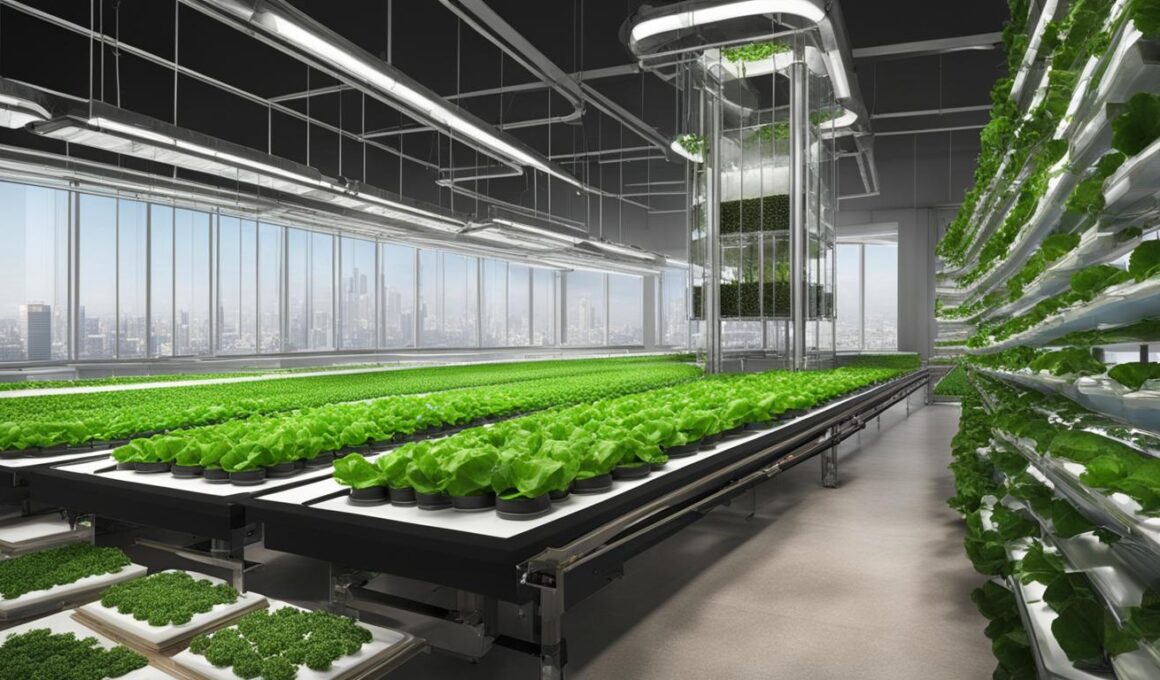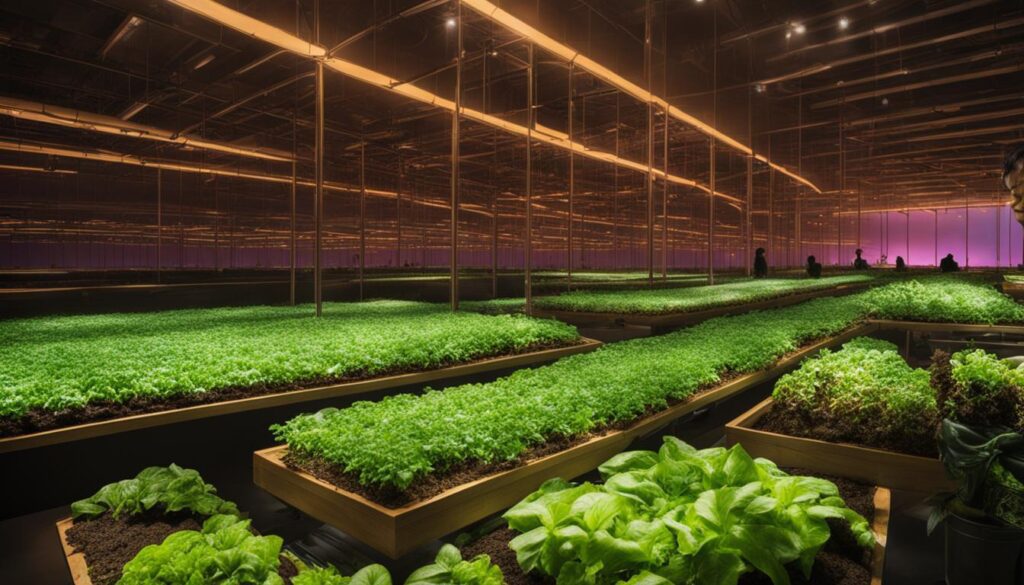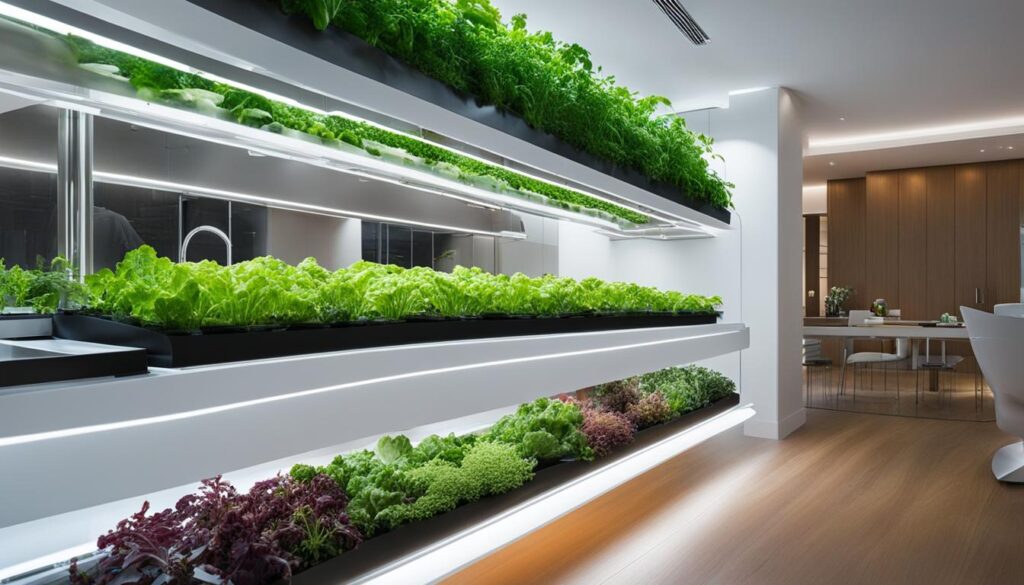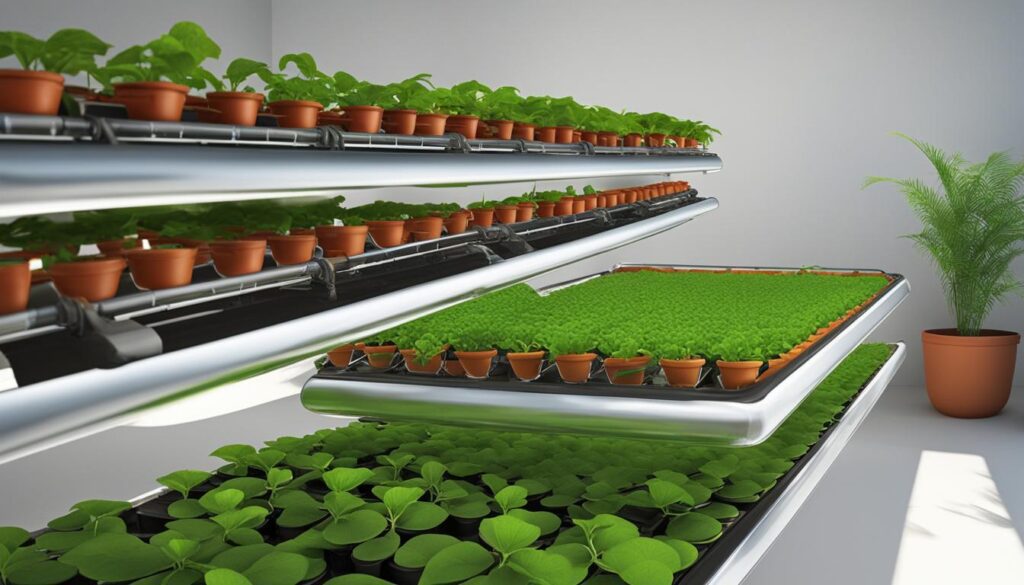Are you considering hydroponics for your indoor gardening journey? Hydroponics is a sustainable method of food production that has been gaining popularity in recent years. But, is it worth it? Let’s dive into the key benefits and drawbacks of hydroponics to help you make an informed decision.
Post Summary
- Hydroponics offers high-quality food production without pesticides.
- It consumes less water compared to conventional agriculture.
- The controlled environment of hydroponics improves yield and maximizes space utilization.
- However, hydroponics has high setup costs and requires regular maintenance.
- Consider your available space, budget, and dedication to maintenance before investing in hydroponics.
What is Hydroponic Farming?
Hydroponic farming is a revolutionary method of growing crops without soil. Instead of relying on traditional soil-based agriculture, hydroponics utilizes a water solution medium to provide plants with the necessary nutrients for growth. This innovative technique has gained popularity among gardeners and farmers alike, offering numerous advantages and possibilities for indoor cultivation.
In hydroponic farming, plants are grown in an environment where their roots are directly exposed to the nutrient-rich water solution. This enables plants to absorb nutrients more efficiently and promotes faster and healthier growth. Hydroponics is suitable for both small-scale and large-scale settings, making it an accessible option for individuals with limited space or no access to outdoor gardens.
However, it’s important to note that not all plants thrive in a hydroponic system. Certain plants with deep roots or those that grow tall may not be well-suited for this method. Nevertheless, hydroponic farming offers a range of possibilities for cultivating a wide variety of crops without the need for traditional soil-based practices.
| Crop | Suitable for Hydroponic Farming |
|---|---|
| Lettuce | Yes |
| Tomatoes | Yes |
| Carrots | No |
| Corn | No |
| Strawberries | Yes |
As the table above demonstrates, certain crops are highly suitable for hydroponic farming, while others may not yield desirable results. The versatility and efficiency of hydroponics make it an attractive option for those looking to explore alternative methods of crop production.
How Does Hydroponic Farming Work?
Hydroponic farming is a unique method of growing plants that eliminates the need for soil and relies on a water solution to provide essential nutrients directly to the plant roots. This innovative approach to agriculture offers several advantages, including improved water efficiency and the ability to grow plants in areas with limited access to arable land. To understand how hydroponic farming works, let’s explore the two main systems used in this method: active and passive.
Active System:
In an active hydroponic system, water and nutrient solutions are continuously circulated to ensure a constant supply of essential elements to the plants. This system typically involves the use of pumps to deliver the water solution through a network of pipes or channels to the plant roots. The continuous circulation helps maintain optimal nutrient levels and ensures that the plants receive adequate hydration. This system is ideal for larger-scale hydroponic setups where precise nutrient delivery is necessary.
Passive System:
The passive hydroponic system, on the other hand, relies on the natural force of gravity or occasional flooding to deliver the nutrient solution to the plant roots. This system is simpler and more suitable for smaller-scale setups or home gardening. The nutrient solution is stored in a reservoir that is located above the plants, and the solution gradually flows down to the roots through capillary action. The passive system requires less maintenance and equipment compared to the active system.
| System | Advantages | Disadvantages |
|---|---|---|
| Active | – Precise nutrient delivery | – Higher setup and maintenance costs |
| Passive | – Simple and low-cost | – Limited control over nutrient delivery |
Both active and passive hydroponic systems have their strengths and weaknesses, and the choice between the two depends on the specific needs and resources of the gardener. Regardless of the system used, hydroponic farming offers an efficient way to provide plants with the necessary nutrients for growth, resulting in healthier plants and potentially higher yields.
Advantages of Hydroponic Farming
Hydroponic farming offers several advantages that make it an attractive option for indoor gardening. One of the key benefits is the ability to produce high-quality food. By eliminating soil as a growing medium, hydroponics reduces the risk of pests and diseases that can impact crop quality. This results in healthier, more flavorful produce that is free from pesticide residues.
Another advantage of hydroponic farming is the significant reduction in water consumption. Traditional agriculture requires large amounts of water for irrigation, but hydroponics uses a recirculating system that conserves water. This makes hydroponics particularly well-suited for regions facing water shortages or areas where access to water is limited.
The controlled environment of hydroponic farming allows for optimal use of space. By growing crops vertically or in compact systems, hydroponics maximizes the available area and increases yield. This makes it a viable option for urban areas with limited agricultural land, where space is a premium.
In summary, hydroponic farming offers several advantages, including high-quality food production, reduced water consumption, and optimal use of space. These benefits make hydroponics a valuable option for individuals looking to grow their own fresh and nutritious produce in a sustainable and efficient manner.
| Advantages of Hydroponic Farming |
|---|
| High-quality food production |
| Reduced water consumption |
| Optimal use of space |
Disadvantages of Hydroponic Farming
While hydroponic farming has its benefits, it also comes with several drawbacks that need to be considered. One of the main disadvantages is the high set-up cost associated with hydroponic systems. The initial investment can be significant, especially for larger-scale setups that require expensive equipment and infrastructure. These costs can include purchasing pumps, tanks, lighting equipment, and nutrient solutions, as well as establishing a controlled environment for optimal plant growth.
In addition to the high set-up cost, hydroponic farming also requires regular maintenance and monitoring. The components of a hydroponic system need to be properly maintained to ensure their efficient functioning. This includes monitoring nutrient levels, pH balance, and water circulation, among other factors. Failure to maintain these components can result in poor plant growth and even system failure.
Another challenge with hydroponic farming is the potential spread of waterborne diseases among plants. The continuous circulation of water in hydroponic systems can create a favorable environment for pathogens to thrive. As a result, special care and attention are required to prevent and manage disease outbreaks in hydroponic farms.
Expert Quote:
“Hydroponic farming can be a highly rewarding endeavor, but it’s important to acknowledge the drawbacks. The high set-up cost and ongoing maintenance requirements can be significant barriers for aspiring hydroponic farmers. However, with proper planning, knowledge, and dedication, these challenges can be overcome, and hydroponics can be a sustainable and profitable method of food production.” – hydroponic farming expert
Cost Comparison – Hydroponic Farming vs. Traditional Soil Cultivation
| Hydroponic Farming | Traditional Soil Cultivation | |
|---|---|---|
| Set-up Cost | High | Lower |
| Maintenance Requirements | Regular and ongoing | Varies |
| Water Consumption | Reduced | Higher |
| Yield | Increased | Varies |
The table above provides a comparison of costs and benefits between hydroponic farming and traditional soil cultivation. While hydroponic farming requires a higher initial investment and ongoing maintenance, it offers reduced water consumption and increased yield potential. Traditional soil cultivation may have lower set-up costs and lower maintenance requirements, but it typically consumes more water and may not achieve the same level of yield optimization as hydroponics.
Are Indoor Hydroponic Gardens Worth the Investment?
Indoor hydroponic gardens can be a worthwhile investment for individuals passionate about fresh and nutrient-rich produce. These gardens offer a gardening solution for those with limited space or who are prone to weather-related crop failures. The investment costs for indoor hydroponic gardens vary depending on the system chosen, but they can provide a consistent supply of fresh produce and allow for control over growth requirements.
When considering the worth of an indoor hydroponic garden, it’s essential to weigh the benefits against the associated costs. While the initial setup cost can be a significant investment, especially for larger-scale systems, the long-term benefits can outweigh this expense. With proper maintenance and monitoring, indoor hydroponic gardens can provide a steady stream of high-quality produce, reducing the need for expensive grocery store purchases and potentially saving money in the long run.
One of the key advantages of indoor hydroponic gardens is their ability to provide a controlled environment for plant growth. This controlled setting allows for precise control over factors such as temperature, lighting, and nutrient levels, which can result in faster growth rates and higher yields compared to traditional soil gardening methods. This increased productivity can translate to cost savings and a higher return on investment over time.
In conclusion, while there are upfront costs involved in setting up and maintaining an indoor hydroponic garden, the potential benefits and long-term savings make it a worthwhile investment for those passionate about indoor gardening and sustainable food production. By weighing the advantages, such as consistent access to fresh produce and the ability to control plant growth conditions, against the associated costs, individuals can determine if an indoor hydroponic garden is worth the investment for their specific needs and circumstances.
Comparison of Indoor Hydroponic Gardens vs. Traditional Soil Gardening
| Indoor Hydroponic Gardens | Traditional Soil Gardening | |
|---|---|---|
| Space Requirements | Minimal space needed; suitable for small indoor areas | Requires larger outdoor garden space |
| Water Usage | Uses significantly less water compared to traditional gardening | Higher water usage, especially in dry climates |
| Pest Control | Reduced risk of pest infestation due to controlled indoor environment | Potential for pest damage and the need for pesticide use |
| Yield | Potential for faster growth rates and higher yields | Yield can vary depending on soil quality and external factors |
| Quality of Produce | Consistent access to fresh, nutrient-rich produce | Quality can be influenced by soil conditions and external factors |
| Upfront Costs | Initial investment required for setup and equipment | Minimal upfront costs; expenses mainly include gardening tools |
| Long-Term Savings | Potential for reduced grocery store expenses and long-term cost savings | Reliance on purchasing produce from stores or farmer’s markets |
The Cost of an Indoor Hydroponic Garden
When considering an indoor hydroponic garden, it’s important to understand the costs involved. From upfront expenses to ongoing running costs, having a clear idea of the financial commitment will help you make an informed decision.
Upfront Costs
The upfront costs of an indoor hydroponic garden can vary depending on the system you choose. If you opt for a DIY setup, you can save on the initial investment, but it will require more time and effort to assemble all the necessary components. On the other hand, ready-to-go kits offer convenience but may come with a higher price tag.
Some of the common upfront costs include:
- Pumps and tanks: These are essential for circulating the water solution through the hydroponic system.
- Lighting equipment: Indoor hydroponic gardens require artificial lighting to simulate sunlight for plant growth.
- Nutrient solutions: These provide the necessary elements for plant nutrition in the absence of soil.
It’s essential to research and compare prices to find the best value for your budget. Additionally, consider the size of your indoor space and the number of plants you intend to grow, as this will affect the overall upfront costs.
Running Costs
In addition to upfront expenses, running costs are an important factor to consider. These ongoing expenses include electricity and water usage, which can vary depending on the size of your setup, the number of plants, and the duration of operation.
Some tips for managing running costs include:
- Energy-efficient lighting: Opt for LED grow lights, which consume less electricity compared to traditional lighting options.
- Water-saving techniques: Implement water recycling systems or use water-efficient irrigation methods to minimize water consumption.
By being mindful of energy and water usage, you can reduce the ongoing running costs of your indoor hydroponic garden.
| Expense | Estimated Cost Range |
|---|---|
| Pumps and Tanks | $50 – $200 |
| Lighting Equipment | $100 – $300 |
| Nutrient Solutions | $20 – $50 |
| Electricity (monthly) | $10 – $50 |
| Water (monthly) | $5 – $20 |
“Investing in an indoor hydroponic garden requires careful consideration of upfront and running costs. However, with proper planning and cost-saving measures, it can be a rewarding and sustainable venture for growing your own fresh produce.”
While indoor hydroponic gardens do involve costs, the ability to have a consistent supply of fresh produce and control over growth requirements can make it a worthwhile investment. Before diving in, take the time to research and compare the prices of different components and systems. By understanding the upfront costs and managing ongoing expenses, you can create an indoor hydroponic garden that fits your budget and provides you with the joy of growing your own food.
Examining the Costs and Drawbacks of Hydroponics
When considering the costs of hydroponics, it’s important to examine both the upfront investments and ongoing utility expenses. Hydroponic systems can have various costs associated with them, including energy costs for heating and electricity usage, as well as startup costs for materials such as pumps, tanks, and lighting equipment. The utility costs of a hydroponic system include ongoing expenses for heating, electricity, nutrient solutions, and water usage.
In terms of utility costs, hydroponics may require higher energy usage compared to traditional soil cultivation, particularly if supplemental lighting and climate control systems are used. However, it’s worth noting that hydroponics offers faster growth rates and higher yields, making it a cost-effective and efficient method of farming in the long run.
To help illustrate the costs and benefits of hydroponics, let’s take a look at the following table:
| Hydroponics | Traditional Soil Cultivation | |
|---|---|---|
| Startup Costs | Varies depending on system size and features | Depends on land preparation, irrigation, and equipment |
| Energy Usage | May require higher energy usage for heating and lighting | Relies on natural sunlight |
| Water Usage | Requires less water compared to traditional farming | Relies on natural rainfall and irrigation |
| Growth Rate and Yield | Offers faster growth rates and higher yields | May experience slower growth and lower yields |
As shown in the table, hydroponics typically requires higher upfront costs for system setup and ongoing utility expenses. However, it compensates for these costs with faster growth rates, higher yields, and reduced water consumption. This makes hydroponics an attractive option for those looking for sustainable and productive farming methods.
Why Hydroponics is Worth Considering
Despite the initial investments and utility costs, hydroponics offers significant advantages. Not only does it allow for optimal use of space and higher crop yields, but it also provides greater control over plant growth conditions, resulting in healthier and more nutritious produce. Additionally, hydroponics eliminates the need for pesticides, making it a safe and environmentally friendly choice for food production. So, while there may be costs involved, the benefits of hydroponics make it a worthwhile investment for those passionate about sustainable agriculture.
What Can I Do to Make More Money from Hydroponics?
Hydroponics not only offers the opportunity to grow your own fresh and nutrient-rich produce but also has the potential to be a profitable venture. To maximize profitability in hydroponics, there are several strategies you can implement:
- Reduce Energy Costs: One of the major expenses in hydroponics is energy consumption. To reduce energy costs, consider utilizing natural light as much as possible or implementing a scheduled lighting system. This can help reduce the need for artificial lighting and lower electricity usage.
- Choose Profitable Plants: Certain plants are more profitable than others in hydroponics. Lettuce, cilantro, and microgreens are popular choices that grow quickly and have a high demand in the market. By growing and selling these profitable plants, you can increase your returns on investment.
In addition to these strategies, considering aquaponics can further enhance the profitability of your hydroponic system. Aquaponics combines hydroponics with aquaculture, creating a symbiotic relationship between fish and plants. The waste produced by the fish provides nutrients for the plants, and the plants help purify the water for the fish. This integration can improve efficiency, reduce the need for external nutrient solutions, and increase overall yield.
By implementing these measures and choosing the right plants, you can maximize the profitability of your hydroponic venture. However, it’s important to conduct thorough research, monitor market trends, and develop a solid business plan to ensure long-term success.
| Strategy | Benefits |
|---|---|
| Reduce Energy Costs | – Lower electricity usage – Decreased operational expenses |
| Choose Profitable Plants | – Higher returns on investment – Increased market demand |
| Aquaponics | – Improved efficiency – Reduced need for external nutrient solutions – Increased overall yield |
Implementing these strategies can help boost the profitability of your hydroponic system and make your venture more economically rewarding.
Hydroponic Cost-Benefit Ratio: In-Depth Study
When considering the profitability of hydroponics, it is crucial to analyze the cost-benefit ratio. Numerous studies have demonstrated that medium-scale hydroponic systems can offer an attractive return on investment. With a payback time ranging from 2 to 4 years and a return on investment of 20 to 40%, hydroponics has proven to be a profitable venture for individuals and businesses alike.
One of the key factors contributing to the profitability of hydroponics is its efficient use of resources. Hydroponic systems are highly water-efficient, as the nutrient-rich water is recirculated, reducing water consumption compared to traditional soil cultivation. This not only helps conserve water but also minimizes the overall operational costs associated with irrigation.
In addition to water efficiency, hydroponics allows for optimal space utilization, making it an attractive option for urban settings and regions with limited agricultural land. By maximizing the use of available space and utilizing vertical growing methods, hydroponic systems can yield higher productivity per square foot compared to traditional farming techniques.
| Hydroponics | Traditional Soil Cultivation | |
|---|---|---|
| Water Consumption | Reduced | Higher |
| Space Utilization | Optimal | Limited |
| Productivity per Square Foot | Higher | Lower |
By considering both the cost and benefit aspects, it becomes evident that hydroponics offers a promising cost-benefit ratio. While there are initial setup costs and ongoing expenses associated with hydroponic systems, the potential for higher yields, reduced water usage, and improved efficiency make it a viable and profitable solution for those looking to venture into sustainable food production.
It is important to note that the profitability of hydroponics can vary depending on various factors such as crop selection, market demand, and local conditions. Conducting a thorough feasibility study and market analysis is essential to determine the potential profitability of your specific hydroponic venture.
Conclusion
In conclusion, hydroponics presents a sustainable and efficient method of food production that offers a range of benefits. The controlled environment of hydroponic farming allows for high-quality food production without the use of pesticides, making it a healthier option. Additionally, hydroponics reduces water consumption significantly, making it an ideal choice for areas with water shortages. The improved yield and optimal use of space in hydroponic systems make them suitable for urban areas and regions with limited agricultural land.
However, it is important to consider the drawbacks of hydroponics as well. The initial setup costs can be high, especially for larger-scale systems, and regular maintenance is necessary to ensure the proper functioning of the components. The continuous circulation of water in hydroponic systems can also potentially lead to the spread of waterborne diseases among plants. Additionally, operating a hydroponic system effectively requires specialized expertise. The organic certification of hydroponic plants is also a topic of debate among organic farmers.
Whether hydroponics is worth it for you depends on individual circumstances. Factors such as available space, budget, and dedication to maintenance should be considered. However, considering the potential for higher yields, reduced water usage, and improved efficiency, hydroponics can be a worthwhile investment for those passionate about indoor gardening and sustainable food production.
What Are the Benefits and Drawbacks of Using a Hydroponics Grow Tent for Growing Plants?
When it comes to growing plants, using a hydroponics grow tent has its own set of pros and cons. Some of the benefits include controlled environment, increased yield, and efficient use of water. However, drawbacks may include high initial cost, potential for system failure, and reliance on electricity. Overall, weighing the hydroponics grow tent pros and cons is important before making a decision.
FAQ
Is hydroponics worth it?
Hydroponics can be a worthwhile investment for individuals passionate about fresh and nutrient-rich produce. It offers high-quality food production, reduced water consumption, improved yield, and optimal space utilization.
What is hydroponic farming?
Hydroponic farming is a method of growing crops without soil, using a water solution medium to provide the necessary nutrients to the plants. It is suitable for both small- and large-scale settings, making it accessible to individuals with limited space or no garden.
How does hydroponic farming work?
In hydroponic farming, plants receive all the essential nutrients through a water solution that is delivered directly to their roots. There are two main systems: active system, which circulates the water solution through pumps, and passive system, which relies on gravity or flooding to deliver the solution to the roots.
What are the advantages of hydroponic farming?
Hydroponic farming offers several advantages, including high-quality food production without the use of pesticides, reduced water consumption compared to conventional agriculture, improved yield, and optimal space utilization.
What are the disadvantages of hydroponic farming?
Some drawbacks of hydroponic farming include high initial set-up costs, regular maintenance requirements, the potential spread of waterborne diseases among plants, and the ongoing debate about organic certification for hydroponic plants.
Are indoor hydroponic gardens worth the investment?
Indoor hydroponic gardens can be a worthwhile investment for those with limited space or who are prone to weather-related crop failures. They provide a consistent supply of fresh produce and allow for control over growth requirements.
What is the cost of an indoor hydroponic garden?
The cost of an indoor hydroponic garden can vary depending on the system chosen. It includes upfront costs such as pumps, tanks, lighting equipment, and nutrient solutions, as well as ongoing running costs like electricity and water usage.
What are the costs and drawbacks of hydroponics?
Hydroponic systems have costs associated with them, including energy costs, startup costs for materials, and ongoing utility expenses. However, hydroponics offers faster growth rates and higher yields compared to soil cultivation, making it a cost-effective and efficient method of farming.
What can I do to make more money from hydroponics?
To maximize the profitability of hydroponics, you can reduce energy costs by utilizing natural light or implementing scheduled lighting. Choosing profitable plants and considering aquaponics, which combines hydroponics with aquaculture, can also contribute to higher returns.
What is the hydroponic cost-benefit ratio?
Studies have shown that medium-scale hydroponic systems can have a payback time of 2 to 4 years, with a return on investment of 20 to 40%. Hydroponics is highly efficient in water usage and space utilization, making it a profitable venture.
What is the conclusion on hydroponics?
Hydroponics offers numerous benefits, including high-quality food production, reduced water consumption, improved yield, and optimal space utilization. However, it also has its drawbacks, such as high set-up costs and maintenance requirements. Whether hydroponics is worth it depends on individual circumstances, such as available space, budget, and dedication to maintenance.













